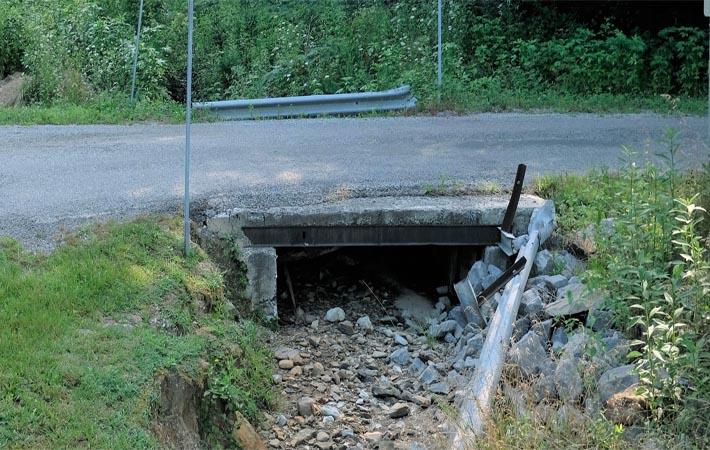A low-cost, low-maintenance, technologically advanced composites bridge deck system will soon replace a damaged, decades-old concrete bridge just off a narrow, curvy rural road in north central Tennessee’s Morgan County. The initiative aims at demonstrating effectiveness of fibre-reinforced polymer composite materials, or FRPs, in bridges across the US.
The bridge with a 100-year lifespan is being built as part of a privately funded infrastructure project aimed at demonstrating fibre-reinforced polymer composite materials, or FRPs, as a fast and easy sustainable solution for improving the thousands of structurally deficient rural bridges that plague financially strapped counties across the US.A low-cost, low-maintenance, technologically advanced composites bridge deck system will soon replace a damaged, decades-old concrete bridge just off a narrow, curvy rural road in north central Tennessee's Morgan County. The initiative aims at demonstrating effectiveness of fibre-reinforced polymer composite materials, or FRPs, in bridges across the US.#
Located one-hour northwest of Knoxville on Elizabeth Church Road, the two-lane bridge has needed repair for many years, Morgan County highway superintendent Joe Henry Miller said. Miller and county officials are partnering with private industry and researchers at the University of Tennessee (UT) and the Institute for Advanced Composites Manufacturing Innovation, or IACMI—The Composites Institute, in Knoxville to create an affordable bridge that can be installed quickly and will safely meet transportation needs in the rural community.
“For more than 20 years, FRP composites have been used in bridge applications, and they’ve met and exceeded all performance and safety standards set by the Association of State Highway and Transportation Officials,” said John Unser, IACMI technology impact manager. “But when it comes to composite bridge decking, many transportation departments across the country are unfamiliar with the technology.
“As part of our objectives for sustainability and strategic planning, our goal in this demonstration is to develop a comprehensive case study for comparing the total costs of a typical concrete bridge and one using an FRP bridge deck. We will share the case study framework and results with federal, state and local officials, transportation departments and the civil engineering community so FRP composites will be more of a ‘known’ to them,” Unser said.
The next-generation composites bridge deck design has already been tested in Oklahoma and Missouri, Unser said, and those trials have provided a greater understanding of the bridge’s strength properties and confidence in the long-lasting, low-maintenance design.
Fibre-reinforced polymer composites products produced in the US offer durable, sustainable and cost-effective solutions not only in bridges but in a variety of infrastructure and transportation applications as well, including highways, dams, railroads, semi-trailers, aircraft, waterfront structures, utility poles and buildings.
The Morgan County demonstration bridge has caught the attention of the Tennessee Department of Transportation (TDOT), a supporter of accelerated and innovative bridge design and construction techniques.
“The use of fibre reinforced polymer bridge deck units, as being coordinated by the University of Tennessee and?IACMI, has the potential to greatly enhance the performance, durability and service life of our low volume rural bridge network across the state,” said Ted Kniazewycz, TDOT structures division director.
The bridge surface, being produced by Florida-based Structural Composites, will have double 8 ft x 25 ft fibre reinforced polymer deck panels. The 8 ft x 25 ft. FRP deck panels are being fabricated using a hand layup process. Abutments are made from concrete using standard fabrication methods. Steel beams are attached to the abutments using standard methods. Then the FRP decks are bonded and bolted onto the steel beams.
A team of researchers at UT’s Fibres and Composites Manufacturing Facility is working with IACMI and the bridge project team to equip the new FRP bridge deck with high-density fibre optic sensors and a state-of-the-art wireless sensor module system to monitor the composite bridge deck system while in service.
Luna Innovations Incorporated out of Roanoke, Virginia, developed the high-density fibre optic sensors and fibre Bragg grating sensors. A single 10-metre sensor can provide strain from mechanical loading or thermal/hygroscopic loading from thousands of locations simultaneously with exceptional precision. These are easy to install while composite decks are manufactured and become part of the structural component. In addition, wireless technology developed at UT will be utilised for monitoring the response of the bridge system and traffic counts remotely via cloud computing.
“Lack of durability data is one of the major barriers of the adoption of novel and advance materials including carbon, basalt, or glass fibre reinforced polymeric composites in civil infrastructure,” said Dayakar Penumadu, the Fred N Peebles Professor in the Tickle College of Engineering and Characterisation Fellow for Materials and Processing group for IACMI.
Penumadu added, “this is a major obstacle for integrating new materials and structures quickly and thus require successful demonstration as being done through this IACMI project. Bridge decks are the most damage prone elements and we are integrating smart sensors distributed throughout the composite bridge deck that will provide us valuable performance data with time for years to come.”
Jeff McCay, CEO of Chattanooga, Tennessee–based Composite Applications Group, or CAG, has been instrumental in getting the rural bridge project off the ground. “We have pulled together a unique team of public-private partners to address a specific need that exists in many rural communities in Tennessee and across the country: structurally deficient or obsolete bridges,” he said.
When McCay learned Morgan County officials were looking for a highly durable, low-maintenance solution to replace the bridge, he saw an opportunity to incorporate composite bridge technology from Structural Composites and began discussions with IACMI and UT, along with in-state excavating contractor McKinney Excavating Inc. of Athens, Tn.
McKinney Excavating owner Brian McKinney welcomed the chance to partner in the project. “We see this as a great opportunity to showcase FRP composite bridges as a great product and be at the forefront of cutting-edge technology and its implementation,” McKinney said.
Fibre2Fashion News Desk (SV)


